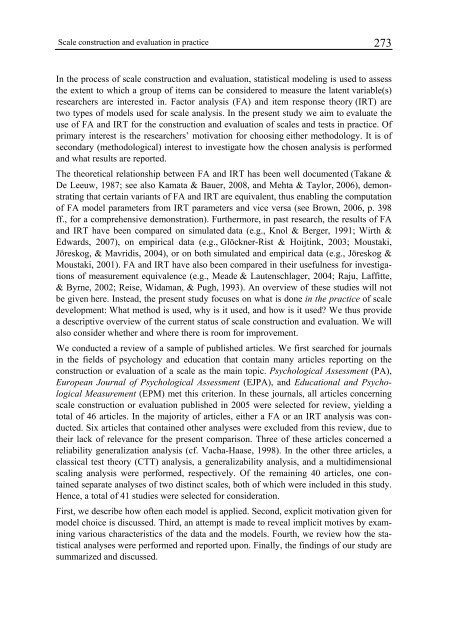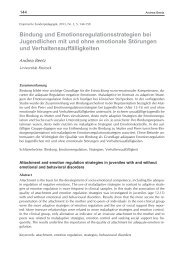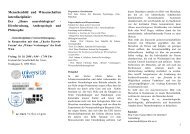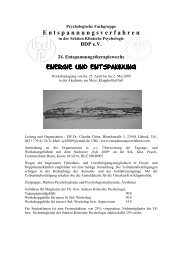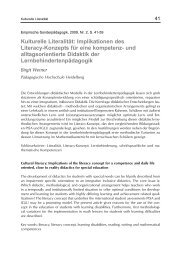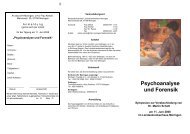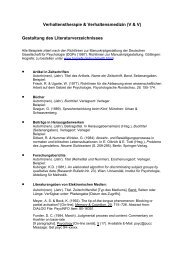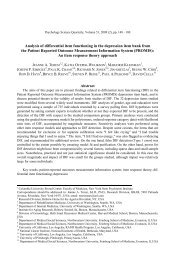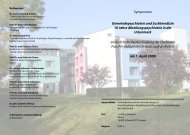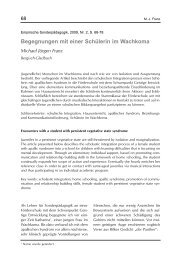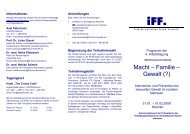Scale construction and evaluation in practice: A review of factor ...
Scale construction and evaluation in practice: A review of factor ...
Scale construction and evaluation in practice: A review of factor ...
Create successful ePaper yourself
Turn your PDF publications into a flip-book with our unique Google optimized e-Paper software.
<strong>Scale</strong> <strong>construction</strong> <strong>and</strong> <strong>evaluation</strong> <strong>in</strong> <strong>practice</strong> 273<br />
In the process <strong>of</strong> scale <strong>construction</strong> <strong>and</strong> <strong>evaluation</strong>, statistical model<strong>in</strong>g is used to assess<br />
the extent to which a group <strong>of</strong> items can be considered to measure the latent variable(s)<br />
researchers are <strong>in</strong>terested <strong>in</strong>. Factor analysis (FA) <strong>and</strong> item response theory (IRT) are<br />
two types <strong>of</strong> models used for scale analysis. In the present study we aim to evaluate the<br />
use <strong>of</strong> FA <strong>and</strong> IRT for the <strong>construction</strong> <strong>and</strong> <strong>evaluation</strong> <strong>of</strong> scales <strong>and</strong> tests <strong>in</strong> <strong>practice</strong>. Of<br />
primary <strong>in</strong>terest is the researchers’ motivation for choos<strong>in</strong>g either methodology. It is <strong>of</strong><br />
secondary (methodological) <strong>in</strong>terest to <strong>in</strong>vestigate how the chosen analysis is performed<br />
<strong>and</strong> what results are reported.<br />
The theoretical relationship between FA <strong>and</strong> IRT has been well documented (Takane &<br />
De Leeuw, 1987; see also Kamata & Bauer, 2008, <strong>and</strong> Mehta & Taylor, 2006), demonstrat<strong>in</strong>g<br />
that certa<strong>in</strong> variants <strong>of</strong> FA <strong>and</strong> IRT are equivalent, thus enabl<strong>in</strong>g the computation<br />
<strong>of</strong> FA model parameters from IRT parameters <strong>and</strong> vice versa (see Brown, 2006, p. 398<br />
ff., for a comprehensive demonstration). Furthermore, <strong>in</strong> past research, the results <strong>of</strong> FA<br />
<strong>and</strong> IRT have been compared on simulated data (e.g., Knol & Berger, 1991; Wirth &<br />
Edwards, 2007), on empirical data (e.g., Glöckner-Rist & Hoijt<strong>in</strong>k, 2003; Moustaki,<br />
Jöreskog, & Mavridis, 2004), or on both simulated <strong>and</strong> empirical data (e.g., Jöreskog &<br />
Moustaki, 2001). FA <strong>and</strong> IRT have also been compared <strong>in</strong> their usefulness for <strong>in</strong>vestigations<br />
<strong>of</strong> measurement equivalence (e.g., Meade & Lautenschlager, 2004; Raju, Laffitte,<br />
& Byrne, 2002; Reise, Widaman, & Pugh, 1993). An overview <strong>of</strong> these studies will not<br />
be given here. Instead, the present study focuses on what is done <strong>in</strong> the <strong>practice</strong> <strong>of</strong> scale<br />
development: What method is used, why is it used, <strong>and</strong> how is it used? We thus provide<br />
a descriptive overview <strong>of</strong> the current status <strong>of</strong> scale <strong>construction</strong> <strong>and</strong> <strong>evaluation</strong>. We will<br />
also consider whether <strong>and</strong> where there is room for improvement.<br />
We conducted a <strong>review</strong> <strong>of</strong> a sample <strong>of</strong> published articles. We first searched for journals<br />
<strong>in</strong> the fields <strong>of</strong> psychology <strong>and</strong> education that conta<strong>in</strong> many articles report<strong>in</strong>g on the<br />
<strong>construction</strong> or <strong>evaluation</strong> <strong>of</strong> a scale as the ma<strong>in</strong> topic. Psychological Assessment (PA),<br />
European Journal <strong>of</strong> Psychological Assessment (EJPA), <strong>and</strong> Educational <strong>and</strong> Psychological<br />
Measurement (EPM) met this criterion. In these journals, all articles concern<strong>in</strong>g<br />
scale <strong>construction</strong> or <strong>evaluation</strong> published <strong>in</strong> 2005 were selected for <strong>review</strong>, yield<strong>in</strong>g a<br />
total <strong>of</strong> 46 articles. In the majority <strong>of</strong> articles, either a FA or an IRT analysis was conducted.<br />
Six articles that conta<strong>in</strong>ed other analyses were excluded from this <strong>review</strong>, due to<br />
their lack <strong>of</strong> relevance for the present comparison. Three <strong>of</strong> these articles concerned a<br />
reliability generalization analysis (cf. Vacha-Haase, 1998). In the other three articles, a<br />
classical test theory (CTT) analysis, a generalizability analysis, <strong>and</strong> a multidimensional<br />
scal<strong>in</strong>g analysis were performed, respectively. Of the rema<strong>in</strong><strong>in</strong>g 40 articles, one conta<strong>in</strong>ed<br />
separate analyses <strong>of</strong> two dist<strong>in</strong>ct scales, both <strong>of</strong> which were <strong>in</strong>cluded <strong>in</strong> this study.<br />
Hence, a total <strong>of</strong> 41 studies were selected for consideration.<br />
First, we describe how <strong>of</strong>ten each model is applied. Second, explicit motivation given for<br />
model choice is discussed. Third, an attempt is made to reveal implicit motives by exam<strong>in</strong><strong>in</strong>g<br />
various characteristics <strong>of</strong> the data <strong>and</strong> the models. Fourth, we <strong>review</strong> how the statistical<br />
analyses were performed <strong>and</strong> reported upon. F<strong>in</strong>ally, the f<strong>in</strong>d<strong>in</strong>gs <strong>of</strong> our study are<br />
summarized <strong>and</strong> discussed.


